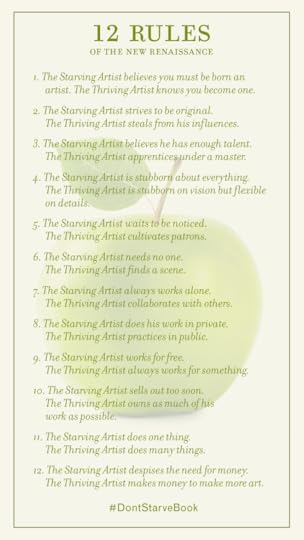Jeff Goins's Blog, page 24
July 21, 2017
How to Write Your Best Book: Part Three (Clarity)
We often start out with a specific intent when we begin a new project. We’re out to prove an argument and make a point. But what happens when, in the course of writing, we discover new truths that derail our message?

When author and memoir consultant Marion Roach Smith worked at The New York Times, she was told, “Never go out with intent. Even when you know someone has committed a crime.”
The idea was that setting out to capture a story with a verdict already in mind would skew your writing. A good journalist is open to not proving what she thinks to be true. And authors are no exception.
In Part Three of our How to Write Your Best Book series on The Portfolio Life, Marion and I talk about what to do with the results of your research, how to change the position of your book with a publisher, and when you know your book is done.
Listen to the podcast
To listen to the show, click the player below (If you’re reading this via email, please click here).
Show highlights
In this episode, Marion and I discuss:
What I did wrong during the research phase of Real Artists Don’t Starve
How to get really clear on your argument
Why you should not pitch a book to your spouse
A key output that starving artists cannot create
Experiencing a pivot in writing based on research results
Two questions every agent and publisher asks
Why similar books seem to release at the same time
Throwing out your darlings
How to communicate counterpoints to your argument without refuting yourself
One thing no one ever says to a hedge fund manager
The origin of the Real Artists Don’t Starve book title
Accidentally writing two books
Leaning into controversy
Why the first draft is “vomit”
How to stop writing your book
When to start talking about your book in public
The danger of thinking about writing a bestseller
Takeaways
You can write any book, but you cannot write every book. You have to pick one.
See what you believe after you do the research.
“It’s good to acknowledge counter argument so you don’t sound like you live in a cloud.” –Marion Roach Smith
“Never refute yourself.” –Marion Roach Smith
If you want to be a real artist, you have to find a way to make a living.
“You may end up with a better argument after you go out and look.” –Marion Roach Smith
“You better enjoy the work because anything can happen after that.” –Marion Roach Smith
“It’s a gift to be asked to contribute to the pool of reading in the world so try to love it.” –Marion Roach Smith
“Write what you believe. You don’t have to be right. You have to make me think.Marion Roach SmithTweet thisTweet
Resources
How to Write Your Best Book Part 1 and Part 2
The Book Writing Framework
Real Artists Don’t Starve
When did you last begin writing a piece and change your mind part way through? What happened? Share in the comments.

July 17, 2017
Note to All Creatives: Marketing is Your Job
In an interview, the novelist Ian McEwan once complained light-heartedly about what it was like to go out and market a book after spending all the time creating it:
I feel like the wretched employee of my former self. My former self being the happily engaged novelist who now sends me, a kind of brush salesman or double glazing salesman, out on the road to hawk this book. He got all the fun writing it. I’m the poor bastard who has to go sell it.
Every artist can relate. Very few of us got into this business because we wanted to have to manage social media accounts or approve an advertising campaign. Writers became writers because they wanted to write. Actors want to act — not spend two weeks on a grueling press tour. The founder wants to be working on their product, not polishing blog posts for some content marketing side hustle.
But considering how few people get to produce art for a living, and how much drudgery and “hawking” is involved in almost every other industry and profession, this seems like a rather privileged complaint. Who is going to sell your movie, your app, your artwork, your service if not you? Even if you pay someone else a lot of money, how hard are they really going to work?
Nothing has sunk more creative projects than this silly, entitled notion that “I’m just the ideas guy.” Or that McEwan put it, that there is a difference between being an artist and a salesman. In fact, they are the same job.
“Being an artist and a salesman is the same job.Tweet thisTweet
If Not You Then Who?
Who should make the time for your art if not you? What does it say that you’re not willing to roll up your sleeves to get to work telling people about this work you have made? Name one person who should be more invested in the potential success of this project than you.
The idea that the world is waiting with bated breath for another movie, another book, another app? It’s not true. People love classics from the recent and distant past. When Harper-Collins has an imprint called Harper Perennial, for instance, or when catalog albums are outselling new releases, it should tell you something:
People are pretty happy with the old stuff.
To get them to like your stuff is no easy task, then. “’If you build it they will come’ can happen, but to count on that is naive,” Jason Fried explained to me when I asked how he built 37signals, now Basecamp, into a platform with millions of users after pivoting from a Web design company to a Web app company in 2004. “In order for the product to speak for itself, it needs someone to speak to.”
It needs someone to speak for it, too.
As Byrd Leavell, a literary agent, puts it to his clients, “You know what happens if your book gets published and you don’t have any way of getting attention for it? No one buys it.” That can’t be what you want!
There is Plenty of Time
Al Ries and Jack Trout, likely two of the greatest marketers who’ve ever lived, acknowledge that CEOs are very busy. They have meetings, phone calls, business dinners, and countless other day-to-day responsibilities. So, naturally, CEOs delegate the marketing to other people. But this is a huge mistake.
“If you delegate anything,” Ries and Trout say, “you should delegate the chairmanship of the next fund-raising drive. (The vice president of the United States, not the president, attends the state funerals.)” The same is true for creatives. We get it—you have other projects to do, you have a family, you’re busy.
The same goes for artists. If we’re honest with ourselves, we will find that there is plenty of waste inside our artistic routine. Time spent watching TV, time spent on meetings that go nowhere. You can cut back on all this.
Take the time you spend messing around on your personal Facebook and use it to build an online community
Take the time you spend fantasizing about being in the New York Times and spend it developing relationships with people who can get you there.
Take the time you spend dealing with the Resistance, with procrastination, and lean into it. Use those less-than-inspired moments to think about how to build your platform or get attention.
The last thing you can ever afford to skimp on is marketing. Your product needs a champion. As Peter Drucker put it: “[Each project] needs somebody who says, ‘I am going to make this succeed,’ and then goes to work on it.”
That must be you. Marketing is your job. It can’t be passed on to someone else. There is no magical firm — not even mine, which was lucky enough to count Jeff as a client — who can take it totally off your hands.
Even if you’re famous, even if you have a million Twitter followers, even if you have a billion dollars to spend advertising — it’s still on you and it still won’t be easy. It’s on you to make this great thing you’ve made and reach as many people as possible with it.
“Marketing is your job. It can’t be passed on to someone else.Ryan HolidayTweet thisTweet
What’d I’d like you to see is that this isn’t an obligation. It’s an opportunity. It’s perfectly possible to apply same amount of creativity and energy into marketing as you put into making.
Marketing Is Art
Look at brilliant campaigns like Paulo Coelho’s decision to upload his own book on Bittorrent sites in Russian to grow his fan base. Look what he did in Brazil with his publisher to run ads that featured the entire text of his famous novel The Alchemist. It’s a giant block of text in 4.1-point font, so it’s basically impossible to read, but it’s still a stunningly clever and brazen move.
The brilliant ad reads in part, “Thanks to the 70 million who read the book. If you are not one of them, read this ad…” The result was immediate coverage in outlets like Adweek and, of course, much love on social media. He had to do that — he had to lead those efforts.
In 2014, the mostly unknown band Vulfpeck released a 10 song album, Sleepify, all songs featuring 31 seconds of silence. The idea stemmed from the fact Spotify didn’t pay artists until a “proper play” of 30 seconds. By creating this album the band was inserting themselves into the larger discussion of royalty payments to artists.
When the band released the album and encouraged fans to download and play while sleeping (since all the tracks were silent) the band not only earned $20,000 in Spotify royalties, they earned mentions in Rolling Stone, Forbes, Billboard, The Guardian, and many more.
Think about Marc Ecko hustling to send “swag bombs” to influencers—including a hand crafted Malcolm X airbrushed jacket to Spike Lee to celebrate the director’s movie. He was making stuff as his marketing. Over two decades later, Marc and Spike are still working together.
Are creative marketing ideas like this not their own works of art? Wouldn’t your work be served well by applying your muscle and creativity to coming up with something similar?
There are so many great ideas and cool ways to get your work out there, I promise.
Do the thing that you think is crazy–that isn’t allowed (I once helped an artist create a boycott of their own work)
Take a stand. Take a risk.
If you want to be in the news, make news.
Reach out to potential champions of your work (they are desperate for good stuff too)
“Do the thing you think is crazy.Ryan HolidayTweet thisTweet
Jeff talks about the difference between a starving artist and a thriving artist — this is that difference. The desire and the ability and the initiative to get what you’ve made in front of people. To see the whole equation as the artist’s responsibility — not just the time they spend in the studio or at the computer or on stage.
Plenty of people can make great work. Not everyone has the dedication to make it and to make it work. Marketing is an opportunity for you to distinguish yourself, to beat out the other talented folks whose entitlement or laziness holds them back.
So yeah, you have to get out there and hawk your stuff. Not just because if you don’t, who will, but because no one can do it as well as you can.
What has held you back from marketing your work? What are you going to do next to get your work out into the world? Share in the comments.

July 12, 2017
How to Write Your Best Book: Part Two (Research)
It doesn’t matter how good your idea is or how interesting the message. If you haven’t done your research, your writing will lack the credibility it deserves.
How far would you travel to conduct an interview for your book? To what lengths would you go in order to secure a source for your writing? Is research necessary even when you’re doing creative writing?
This week on The Portfolio Life, Marion Roach Smith and I continue the How to Write Your Best Book series with Part Two in which we address these questions and more. In this part, we focus on the topic of research and why it’s essential to do your best writing.
Listen in as we discuss some surprising research methods, what ocean Marion crossed to interview an expert, and why she recommends putting down the keyboard and picking up the phone. All these tips and more influenced the work behind my latest book Real Artists Don’t Starve.
Listen to the podcast
To listen to the show, click the player below (If you’re reading this via email, please click here).
Show highlights
In this episode, Marion and I discuss:
Looking for holes to build on what other people have written
Saying something unique that contributes to the arena
How to use studies and bibliographies to dig deeper
The danger of accidentally building a straw man argument
Surprising results from picking up the phone
Scripts for building rapport with industry experts
Why to avoid referencing celebrities
The one word no one has ever said to Marion
How to find interesting sources and connect with them
The difference between an Internet writer and one who does real research.
Which characteristic of a city gets Marion on the plane to interview someone
When to call, email, or Skype a lead versus flying to meet them
Why remaining vague is a strategic move
A narrative trick that instantly bestows your writing with “street cred”
Quotes and takeaways
“Repurposing the famous is not going to cut it.” –Marion Roach Smith
“Every fact, every interview, should heighten and add to the argument.” –Marion Roach Smith
“Live quotes are always better than repurposed quotes.” –Marion Roach Smith
“There are no tricks to reaching out.” –Marion Roach Smith
It’s easy to assume “no” for someone else and avoid asking them your question.
Never research a piece starting from an intent to prove something. Research to discover the truth.
“Make sure you have one whacky, off-the-wall question.” –Marion Roach Smith
“How do you get top experts to respond to you? You ASK them.Marion Roach SmithTweet thisTweet
Resources
How to Write Your Best Book: Part One
The Book Writing Framework
Real Artists Don’t Starve
What did you last discover while conducting research? Where have you traveled to interview a source? Share in the comments

July 10, 2017
The Rule of the Scene: Why Where You Live Affects the Work You Do
I’ve written before that every story of success is really a story of community. In fact, this was one of the central ideas to my book, Real Artists Don’t Starve. You need a scene. But how do you find one, exactly?
When we look at the lives of successful artists, writers, and creatives, we don’t just see a collection of serendipitous moments. We see strategy. Whether intentional or not, a series of incidents and connections often allow a person’s work to get the attention it deserves.
And this does not happen by accident. At least, not usually.
Perhaps one of the greatest examples of this is how Ernest Hemingway moved to Paris in the 1920s to join a scene of expatriate writers and artists who had taken up residence in the Left Bank. Almost every time I tell this story, someone will ask, “But what if I can’t move?”
Do you have to move across the world to find your scene? What if circumstances prevent you from doing so? Here’s what to do if you find yourself in that situation.
Go where the magic is
The Rule of the Scene, as I call it, states that it’s easier to go where creative work is happening than it is to will yourself to be more creative. The research on this is pretty clear: genius is a group effort, not the result of any single person’s work. The concept of the solitary genius is a myth. We don’t do our best work alone.
“We don’t do our best work alone.Tweet thisTweet
At the same time, not all of us are able to pack up our things and move across the country or the other side of globe to find our scene. Does this mean we’re out of luck? Not exactly.
We need a scene. That much is obvious. But you may not have to move as far as you think. Here’s how this works. If you want to do your best work, you have a choice:
You can either go join a scene.
You can create one right where you are.
Either way, you don’t get out of this. You have to find your scene, even if it means you make it yourself.
Join an existing scene
Let’s look at the first strategy, which we’ll call “Go Join a Scene,” (see Chapter 6 of Real Artists Don’t Starve for more on this). The idea here is there are certain pockets of creativity in the world that are worth tapping into. These places and unique moments in time are sometimes called “creative clusters.”
Researcher Richard Florida writes about the Creative Class, as a group of workers who are particularly drawn to areas of technology and diversity. They intuitively understand that where we live affects what we do and how we do it.
Travel writer Eric Weiner shared the same phenomenon in his book The Geography of Genius. Some places, he argues, seem to have an “it” factor, something that makes that location a hotspot for creative. And if we want to do our best creative work, we would do well to tap into these places.
One quality, according to Weiner, is that these places are unlikely — they can happen anywhere. When Hemingway sees a bunch of poets and painters moving to Paris because the exchange rate is good, he decides to follow. There, he can live on a meager budget while growing as a writer in the company of greatness. So he goes. And he finds his scene.
That’s one way to do it. But of course, there is another.
Create your own scene
You can either do what Hemingway did and go join a scene, or you can create one. Let’s look at that second strategy, which we’ll call “Create Your Own Scene.” If one way to do your best creative work is going where creativity is already happening, the alternative, then, would be to stay put.
This, too, is a strategy. Because for every Hemingway in Paris, there’s a Bronte in Haworth. Haworth, England was a small rural town where the Bronte family made their home. The daughters of a clergyman, Charlotte, Emily, and Anne grew up without much exposure to the outside world. To pass the time and to amuse themselves, they would tell stories to each other.
One day, one of the older sisters Charlotte found some poetry written by Emily, which caused the older sister to share that she, too, had been writing. Before long, it was clear that all three siblings were closet writers, and thus began a literary collaboration that would last a lifetime.
The Bronte sisters would go on to write some of the most influential works of literature in the English language, and it all began in a small village, far from the reaches of civilization. These young women didn’t have to leave home to find their scene. In fact, some of them did leave only to return to Haworth because that was where they did their best work.
Sometimes, the community we need is closer than we realize.
You must move
So which should we do? Go find a scene? Or create one? It may sound like contradictory advice. If you can stay put or leave, then you really don’t have to do anything. But that’s not what I’m saying.
You need a scene. You need to find that place where your people are, that community you can connect and collaborate with to create your best work. And make no mistake. This does requirement movement.
For some of us, that may mean a move across the room, as was the case with the Brontes. For others, it may mean a move overseas, as Hemingway did. In my case, it meant realizing that I lived in a city where creative work was already happening. I just needed to join it. This, too, required action. I had to put myself out there, showing up at local coffee shops and meet-ups where other creative workers like me were gathering. And over time, the more I made myself available to the scene, the more I became a part of it.
If you want to find your scene, you must move. Standing still is not an option. As you consider where you need to do your best work, it may help to understand that a scene requires three things:
A place
A people
A purpose
You need a place to gather, a group of people to connect with, and a reason for meeting. This was true of the Brontes, it was true of Hemingway and the rest of the Lost Generation, and it was even true of the scene that I joined here in Nashville so many years ago.
We do our best work in community. And those communities are found in places, sometimes the ones we least expect. Our job is to go find it, wherever it is. Because once you join your scene, it changes everything.
How to do this today
An example of someone who has done a good job of combining these two strategies is Eric Gale, a member of our Tribe Writers community.
Every year, he has consistently come to the Tribe Conference, going where the creative scene he needs is. But he doesn’t just show up. He makes the most of the experience, taking it upon himself to put together a meet-up for other Tribe Writers in the area. No one asked him to do this. He was just hungry enough for connection with other writers that he decided to create his own community.
This is how you find a scene. You put yourself out there, going where creative work is already happening — whether that’s in your own back yard or perhaps at a nearby (or even faraway) event. You do whatever you can to get to where your people are. And then, you do something like Eric did — you step out, take initiative, and make yourself as helpful as possible to others.
And if you do this well, you win.
So your next steps are simple:
Join an existing scene. Find a place where the people you want to connect with are already gathering. Check out meetup.org or even the Tribe Conference if it’s the right fit for you.
Commit to showing up. Buy a ticket. Schedule that meeting. Do whatever you need to do to get there.
Be helpful. Go above and beyond, just as Eric did, to become the community you need. Help enough people and you’ll be surprised how that generosity has a way of coming back around.
If you’re curious about joining Eric along with a few hundred other writers and creatives this year who are to get the attention their work deserves, check out Tribe Conference.
Click here to reserve your seat before the early bird price expires.
What creative community are you part of? Do you need to join or create a new scene? Share in the comments.

July 5, 2017
How to Write Your Best Book: Part One
Writing your first book can be both an intimidating and exhilarating experience. You are scared and excited at the same time. Turns out, this never goes away. You are always learning and relearning how to write a book.
After writing four books, I assumed it would be easy to tackle my fifth. I was wrong. As my friend Tim Sanders says, genius is a team sport. Writing Real Artists Don’t Starve was no exception to this rule.
“Genius is a team sport.Tweet thisTweet
When I started writing this book, after learning the truth about Michelangelo’s wealth, the nagging idea wouldn’t let go. I knew there was a message worth sharing in there somewhere, but I wasn’t quite sure what it was. I felt stuck.
So, I reached out to author, friend, and writing coach, Marion Roach Smith, for help. During the course of several conversations, Marion walked me through the process of researching, writing, and editing Real Artists Don’t Starve.
In Part 1 of this series on The Portfolio Life, Marion and I talk about why you don’t have to start writing Page 1, visiting Ernest Hemingway’s house in Cuba, and provoking your reader to be successful.
Listen in as we discuss clarifying the argument of your book, creating a “closet” structure to write within, hitting your stubborn beliefs with a hammer.
Listen to the podcast
To listen to the show, click the player below (If you’re reading this via email, please click here).
Show highlights
In this episode, Marion and I discuss:
Why doubt is an indicator of respect for your craft
How reading a book is like an adventure
What questions and doubts reveal about your book’s structure
The original title for Real Artists Don’t Starve
Attending a witch camp to research a book about redheads
The modular method of writing a book
Why you don’t have to be right to write non-fiction
A practical writing strategy for not wasting 40,000 words
Asking surgeons unorthodox questions about their experience in the world
How long to research before you start writing a book
Quotes and takeaways
You re-learn how to write a book every time you write a book.
“We are all apprentices in a craft where no one ever becomes a master.” –Ernest Hemingway
If you have no questions or doubts, you’re not conscious of how textured the writing experience is.
“Books are a cumulative experience.” –Marion Roach Smith
“Once you understand the argument and can put it into a sentence, you can build the best book in the world.” –Marion Roach Smith
“How do you write a book? One word at a time.” –Marion Roach Smith
The best way to get someone to learn something is to put it to music or make it funny.
“You can never stop short of fulfilling that obligation to your reader to make it as good as it can be.” –Marion Roach Smith
“When people cling to the idea that they have to starve to succeed, they’re going to starve.Tweet thisTweet
Resources
The Roots of Desire by Marion Roach Smith
5 Steps to Writing a Great Memoir
The Memoir Manifesto
Real Artists Don’t Starve
What does your research process look like? Where in your book do you start writing first? Share in the comments

June 26, 2017
Learn to Love the Work, or Do Something Else (and Other Lessons on Enduring Greatness)
In our world today, there is a lot of emphasis placed on sudden success. If a book doesn’t hit a bestseller list the week it comes out, it is quickly forgotten. If a record doesn’t hit “the charts” on Week 1, it is considered a failure. But is this how great art is made?

This is a question that has bugged me for years: is it better to be dynamite, exploding onto the scene and then erupting into nothingness, or a candle that burns slow and steady for a long time?
The world would have us believe it is the former, that the overnight successes are what get the riches and attention. But these days, I’m not so sure.
For years, I thought this was the goal: to be a bestseller, to make a million bucks, to be famous. But every time I achieved one of these milestones, I re-learned an old lesson: what makes writing so powerful is not the occasional milestone you achieve, but the process.
“What makes writing so powerful is the process.Tweet thisTweet
You either love it or we don’t.
Learn to love the work (or do something else)
Do you know the phrase “I hate writing, but love having written”? I hate that phrase. It doesn’t make any sense.
You wouldn’t hear a golfer say, “I hate golfing, but I love visiting the bar afterwards.”
You wouldn’t hear an entrepreneur say, “I hate business, but I love making money.”
And you wouldn’t hear a runner say, “I hate running, but love having run.” If they were doing it for hours a day, mile after mile, you’d expect them to love it, right?
But with certain vocations, like writing, we have a different set of criteria. If you want the result, then you should be willing to endure the process. I want to argue that this is the wrong way to think about your craft. It is impatient and unsustainable. Instead, we should adopt a new maxim:
“Learn to love the work, or do something else.”
Anything less is not honoring the process. It’s a shortcut, which may afford you a few quick wins, but won’t lead to long-term success.
Recently, I had some personal experience with this.
Beware the allure of titles
When you’re trying to prove a point and the opposite happens, you’re left with an interesting dilemma. With my latest book, I was intentionally trying to not hit a bestsellers list because I was focusing on the “long game” instead of the short-lived success that so often comes with instant bestsellers.
So many authors strive for the elusive “bestseller” status, not realizing this title in and of itself doesn’t mean much. Many of the books that end up on The New York Times Bestsellers List hit the list for a week or two and then never sell more than a handful of books afterwards. Similarly, the musicians who hit the top of the charts with a single song but never produce anything after are quickly forgotten.
It’s a flash in the pan, not a long, steady flame.
Contrast this “one-hit wonder effect” with the too-many-to-count perennial bestsellers that never hit a major list but continue to sell tens, even hundreds of thousands of books a year. A recent example of this is Ryan Holiday’s book, The Obstacle Is the Way, which never landed on the NYT list but has sold over 400,000 copies and continues to sell every month. How did he do it? By actively avoiding the allure of a title and instead focusing on the slow burn.
When I set out to launch Real Artists Don’t Starve, this was my strategy: long-term growth over short-term success that is quickly forgotten. But then something unexpected happened: the book debuted on The Wall Street Journal Bestsellers List at #6.
I was legitimately surprised, even baffled. And honestly, it felt good. Hitting a list feels good. It does. Even when you know it doesn’t necessarily mean a lot, it feels validating. But that feeling lasts for five, maybe ten, seconds. Then, you’re left with an important question: What now?
In case you don’t know much about this sort of thing (because I didn’t), becoming a bestseller means you sold a significant number of books (think thousands, not millions) in a single week. It doesn’t mean your book will keep selling or that people even liked it. It just means you now have a new title: best-selling author. And here is the essential problem with titles: they can convince us that we’re doing the work when we’re not.
“Titles can convince us that we’re doing the work when we’re not.Tweet thisTweet
Author Derek Sivers has a fascinating antidote for this feeling. He says that you have to keep earning your title or it expires. Even though he had launched and sold companies for tens of millions of dollars, he realized he couldn’t keep calling himself an entrepreneur just because he had run a company years ago. If he wasn’t going to keep launching businesses, then he needed to stop. Here’s why (in his own words):
By using a title without still doing the work, you fool yourself into thinking future success is assured. (“This is who I am!”) That premature sense of satisfaction can keep you from doing the hard work necessary.
Stop fooling yourself. Be honest about what’s past and what’s present. Expiring old titles lets you admit what you’re really doing now.
And if you don’t like the idea of losing your title, then do something about it! This goes for titles like “good friend”, “leader”, or “risk-taker”, too.
Don’t get stuck in failure (or success)
When he was 21 years old, Kevin Smith saw an indie movie called Slacker which inspired him to make movies for a living. He went to film school for four months but dropped out halfway through an eight-month program so that he could keep the $5000 in saved tuition and started making a movie.
His parents gave him $3000 to help him finance the film. He rented a camera and some other gear, asking his friends to act in it as a favor to him. It took only a few weeks to shoot and was shot entirely in black and white.
The public screening only had three people show up. Smith was disappointed: “Why did you do this?” he asked himself. But then 20 minutes into watching it, he relaxed. After the movie was over, he decided to:
Pay the movie off and make another one, because you loved who you were when this was happening.
That line — “you loved who you were when this was happening” — struck me, because I don’t love who I am when I’m launching books or hitting bestsellers lists. I don’t dislike that part of the process, but it’s not me at my best.
What I’m doing when I love who I am is writing. I love working on a book: the research, the ideas, the stories — seeing it all come together. I love living in that in-between place, not knowing what’s about to happen. That is the most thrilling part of the creative process for me: right in the middle when anything’s possible.
Start the next one
When he was just at the beginning of his career and had finished his first novel, Steven Pressfield met with a neighbor who also happened to be a well-established author. Steve asked him for some advice.
“Now that my book is done,” he asked, “what should I do?”
“Start the next one,” the author said.
That’s all we can do. Keep doing the work. Find the thing that makes us feel most alive, and do that. Because the truth is as much as we want to control the outcome, we can’t. All we can control is the process. And that is more than enough to keep us satisfied.
Fun fact: that movie that nobody went to see at the public screening? It ended up doing pretty well. One of the three audience members ended up being someone who was well-known in the film world and started recommending Clerks to everyone he knew. The movie was shown at the Sundance Film Festival, and the rest was history, launching Kevin Smith into a successful career as a filmmaker, where he’s still making films to this day.
Sometimes, even our failures aren’t really failures — as long as we don’t get too caught up on any single achievement and keep creating. It’s worth noting that before all the success, and even through some failures, Smith continues to make his art. Good film, bad film. Big success, huge failure. He understands that his job is to keep creating.
What did I do when I hit a bestsellers list? The same thing I did when I didn’t hit a bestsellers list.
Start writing the next one.
Resources
Here are some resources you may want to check out:
Ryan Holiday has a new book coming out about this idea of creating enduringly great stuff; it’s called Perennial Seller . I just received an advance copy and started reading it. It’s great.
Watch the story of Kevin Smith’s first film here.
Read Derek Sivers’ inspiring post on titles and why they expire if you stop doing the work.
Listen to my interview with Elizabeth Marshall on why being a bestseller is not necessarily synonymous with creating enduring ideas.
What are you doing when you love who you are? Share in the comments.

June 21, 2017
156: Avoid the Ravenous Monster of the Bestseller Game: Interview with Elizabeth Marshall
It’s becoming increasingly apparent that traditional publishing and hitting the bestseller lists is a game. You don’t write a bestseller so much as you launch one. And yet, for those who want their work to endure, the question hangs in the air: is the game worth playing?
As a writer and five-time author, I’d be lying if I told you that hitting the Wall Street Journal bestseller list twice meant nothing to me. Honestly, it feels good.
But you know what?
The two books that hit the list were released very differently.
With the latest title, Real Artists Don’t Starve, I was mostly hands off during launch week while the first book, The Art of Work, I was relentless in knocking on as many doors as possible to ensure it’s success.
Two different books. Two different launches. Two opposite stress levels.
Same result.
This week on The Portfolio Life, author and platform consultant, Elizabeth Marshall, and I talk about key differences between an expert and a thought leader, paths to mastery, and avoiding the allure of bestseller lists in exchange for an enduring message.
Listen in as we discuss the stages of a thought leader, why your message doesn’t always translate across all mediums, and how opportunities lead to more opportunities.
Listen to the podcast
To listen to the show, click the player below (If you’re reading this via email, please click here).
Show highlights
In this episode, Elizabeth and I discuss:
Exploring what it is you’re uniquely called to share
Why knowing the “bookshelf” your work belongs on provides necessary clarity
Challenges of translating workshop principles to book form
Developing habits of consistency and ubiquity
The value of creating a content strategy
10 different elements of a platform
Knowing when to say “no” to enticing offers that don’t align with your purpose and vision
What it takes to become a recognized leader in certain industries
Keeping the message relevant and maintaining fresh connections across your platform
Reaching the stage of unconscious competence
The “charge neutral” nature of marketing tools and best practices
Why chasing a badge of success is an insatiable monster
Quotes and takeaways
Finding your purpose is more of a path than a plan.
“Becoming a thought leader is not for the faint of heart.” –Elizabeth Marshall
You have some control over whether your not your ideas and message endure.
“There is no cookie cutter blueprint that guarantees you’ll be recognized as a thought leader in your industry.” –Elizabeth Marshall
If you don’t know what stage you’re at, you can misapply strategies or try things that you and your audience aren’t ready for.
“Messages have a path of their own. If we’re not listening and open, we might miss some of the greatest trajectories it might take us towards.” –Elizabeth Marshall
If you feel like your message is for everyone, you need to spend more time incubating it.
Be grateful for the opportunities you’re given. No matter how small.
Be present in the moment and make the most of it.
The best relationships are not based on transactions.
Becoming a New York Times bestseller doesn’t happen by accident.
“Remaining in service to a greater calling keeps a rampant ego in check.Tweet thisTweet
Resources
Thought Leader Platform Diagnostic
Book Yourself Solid by Michael Port
The Dip by Seth Godin
Purple Cow by Seth Godin
The Contrarian Effect by Elizabeth Marshall & Michael Port
6 Pixels of Separation (Mitch Joel’s blog)
Getting Things Done by David Allen
The Truth About the New York Times and Wall Street Journal Bestseller Lists by Tim Grahl
Click here to download a free PDF of the complete interview transcript.
Do you consider yourself a thought leader? What stage are you at? Share in the comments

June 19, 2017
Yes, You Actually Can Make Money off Art
Since releasing Real Artists Don’t Starve, I’ve heard from a number of people who don’t believe it’s possible to make a living off your creativity — whether in writing, fine art, or another medium. But is that really true?
For most of my life, I was told a story about what it means to be an artist, a title reserved for that elite group of people who were talented but unlikely to succeed. The advice was always the same:
Don’t quit your day job.
Do this while you’re young.
Always have something to fall back on.
When I was growing up, I was told that creativity, though a nice outlet, was never something you should go “all in” on. Because, odds are, you’ll starve. You may have been told the same.
It turns out, though, that’s just not true.
Real artists don’t starve
For years, the Strategic National Arts Alumni Project (SNAAP) has been surveying graduates of arts programs to see how successful they are in the real world.
Approximately 120,000 degrees in the arts are awarded every year, and the question is, what happens to these people? Not what you think.
You might imagine, as I did, the stereotypical starving artist: the stubborn loner struggling to make ends meet and forsaking every adult concern for the sake of their work.
This is what we have been taught to expect when imagining people in full-time, creative careers. We imagine poverty-stricken souls spending their days slaving away at the work, toiling in agony to create their next masterpiece. We picture Michelangelo on his back, nose to ceiling, paint dripping in his eyes, earning little for his genius.
The SNAAP study, however, revealed something quite different. The majority of trained artists are actually thriving. Here were some fascinating statistics:
70% of these graduates have found jobs within the arts,
75% have been or are self-employed,
99% consider creativity to be an important competency in their profession, and
They report income levels that support families, sustain careers, and enable charitable giving. In other words, they are not starving.
Contrast that with a 2014 US Census Bureau where nearly 75 percent of science, tech, engineering, and mathematics graduates are not employed in their field of study, and we are forced to consider a new reality for modern creatives. Many artists are, in fact, not suffering for their craft. They’re proudly producing work that matters and pays the bills.
So we are brought to a sobering conclusion about creative work:
You can make art and make a living.
You don’t have to suffer to create
Over the past couple years, while writing Real Artists Don’t Starve, I interviewed hundreds of working creatives and came across a surprising fact. When we look at the lives of successful artists, writers, and entrepreneurs, we see a unique mindset:
They don’t believe they have to suffer to succeed.
These people, those I call Thriving Artists, think about themselves and their work differently than those who don’t succeed. Discarding the ways of the Starving Artist, they follow a new set of rules, what I call The Rules of the New Renaissance.
Here they are, all 12 of them:
Find a way to live off your art
These are the things nobody told me — as a kid drawing cartoons, a teenager playing the guitar, and a twenty-something dreaming of writing books.
In my new book, I share story after story of thriving artists who didn’t suffer for their work but instead found a way to live off it. And if we follow in their footsteps, adopting the rules by which they live their lives, we can do the same.
To learn more about how you can stop starving and join the New Renaissance, check out Real Artists Don’t Starve. If you order the book, you’ll get over $100 in free bonus resources. If you order 3+ more copies, you can get some extra goodies, too.
Click here to download the full-size infographic with the 12 Rules of the New Renaissance.
You can also check out Real Artists Don’t Starve here.
Are you working in your field of study? How can you leverage creativity for your advantage at work? Share in the comments.

June 14, 2017
155: What Makes You Unmistakable: Interview with Srini Rao
With over 2.7 million blog posts published every day and hundreds of thousands of books published every year, it’s difficult to stand out from the crowd. Or is it?
More and more, people are looking for an experience with the content they consume. We writers and communicators are all competing with YouTube videos, Facebook notifications, and the latest apps. It takes more than a good idea and plain text on a white background to retain the attention of an audience.
To rise above the noise, you must create something unmistakable.
This week on The Portfolio Life, we are joined by author, podcaster, and instigator, Srini Rao. Listen in as we talk about why your audience needs to feel a sense of belonging, navigating the process of renaming a brand, and appealing to a broad audience without alienating people or diluting the message.
Listen to the podcast
To listen to the show, click the player below (If you’re reading this via email, please click here).
Show highlights
In this episode, Srini and I discuss:
Channeling the innovative mindset of Steve Jobs
Interviewing a variety of guests from bank robbers to performance psychologists
The immeasurable value of creating distinctive work
How the podcast led to a major book deal with Penguin
Avoiding mass production while maintaining consistency
Creating an experience beyond the standard content
Bridging the gap between art and commerce
Repurposing content as a byproduct of your primary medium
Exceeding the perceived limitations of a platform
Surfing as a metaphor for the creative process
Borrowing ingredients from other people to come up with recipes of your own
Building a habit of writing 1000 words a day
The myth of solo-entrepreneurship
How collaboration is an opportunity to elevate someone else
The three jobs of a CEO
Quotes and takeaways
“Connection outlasts any interaction.” –Srini Rao
“Commitment is not negotiable.” –Srini Rao
“When it’s so easy to start, the value of commitment goes up significantly.” –Srini Rao
“The most profitable thing you can do for any company is keep everyone operating within their zone of genius.” –Srini Rao
Constantly look for things that make you curious.
Look at what people are expecting and blow their minds.
Producing a lot of content consistently provides the opportunity to practice in public and get a lot of feedback.
Your reader’s experience extends beyond your words.
Avoid the noise by not subscribing to it.
Treat your platform as an opportunity to be generous.
“The value of distinctive work makes competition irrelevant.Tweet thisTweet
Resources
Unmistakable: Why Only Is Better Than Best by Srini Rao
The Unmistakable Creative podcast
The Unmistakable Creative Compass
Mars Dorian artwork
Unmistakable Creative video shorts by Soul Pancake
AJ Leon
The Rise of Superman by Steven Kotler
How Writing 1,000 Words a Day Changed My Life
Facebook newsfeed eradicator (Chrome extension)
The Big Leap by Gay Hendricks
How to Start a Startup podcast
How would you define something that’s unmistakable? What are you doing that makes your work unmistakable? Share in the comments

June 12, 2017
Book Marketing 101: What Works and What Doesn’t (Lessons from My Latest Launch)
Releasing a book is an interesting phenomenon. By the time launch week rolls around, you’ve been in the trenches with your book for months, if not years. And yet, almost everyone else hasn’t even heard of it yet. So what do you do?
Since the release of my most recent book, people have been asking me things like:
“When do you find out about the best sellers lists?”
“Will you do a book tour?”
“Are you happy with the book’s success?”
While I appreciate the interest in my book, those are some of the most misguided ideas on book marketing a person can have. They are also the most common. So what actually works, and what doesn’t, when it comes to launching books?
And if you’re an author, what should your goal be?
In this post, I’m going to share with you what I’ve learned about book marketing, why my goals are different for this book, and what I’m currently doing to promote it (as well as how you can join me).
Don’t try to be a bestseller (seriously)
When Real Artists Don’t Starve released last week, I knew this would be different from previous book launches. With each project I’ve grown as a writer, researcher, and storyteller, and I can honestly say this is my best work so far.
But I also knew this message would be challenging. The goal of the book was not to hit any bestsellers lists but to bring this idea into the world and see how it was received.
So, will I hit any bestsellers lists?
Short answer: I don’t know.
Longer but truly honest answer: I don’t really care.
That wasn’t the goal. Not because I couldn’t do it, but because there are often tradeoffs to achieve such goals. Short-term gain: you become a best-selling author. Long-term loss: you burn yourself and your audience out by talking the book to death before it even comes out.
This was a lesson I learned from Ryan Holiday and Tim Grahl, both who have worked with authors who have sold millions of books. How did all these mega-bestselling authors do that? They kept talking about the message long after the book was “launched.”
I’ve done the big bestseller launch thing, and it’s not all it’s cracked up to be. I’d much rather sell a reasonable number of books every week forever than a ridiculous amount once and peter out from there.
So that’s the goal of this book — and I’d argue should be the goal of every book — sustained sales. In the end, you’ll sell more books, anyway. Isn’t that what “bestseller” should mean, anyway?
Book tours are (mostly) bogus
Will I do a book tour?
No, not really. Unless you’re a celebrity, these don’t work. You sit in a bookstore staring at an intimidating pile of books you hope will sell while random strangers walk up to you, pick up the thing you’ve dedicated the past two years of your life to, while suspiciously glaring at you, then set it down, and walk away.
I’m not opposed to traveling to meet readers. It’s a nice thing to do for your fans, but this strategy in itself won’t sell a lot of books. You’re much better off doing a bunch of podcasts, blog posts, and articles.
Now, does that mean I won’t be traveling this year, speaking at conferences, schools, and other events? Of course not. I love doing that. But I wouldn’t call that a book tour. A tour is something you do if you are on TV or nationally syndicated radio. It’s not something the average author needs to worry about.
You’re much better off staying home and finding new audiences for your message.
How you should feel after your book launch
Am I happy?
This was a question I’ve been asked nearly a dozen times in the past week. And it’s a funny one to answer.
With this book, I decided to try some new strategies and see how they work. But after only a week, I have no idea how well they’ve worked yet. Since I didn’t go for the big bestseller launch, I’m basically delaying gratification. Book sales, as far as I can tell, went well last week. But as far as I’m concerned, I’m just getting started.
So, am I happy? Sure. I’m glad to have the book out in the world and see people are reading it and enjoying it (already over 50+ 5-star reviews on Amazon!).
All I know is I’m not exhausted like I was with the last book launch, and that’s a good thing. It means I have more energy to keep talking about this book.
This, I think, should be your goal after launching a book: to not already be sick of the book itself. I’m not. I really believe in the message of Real Artists Don’t Starve and plan to talk about this for a very long time.
What’s currently working (where you come in)
The goal for Week 1 of a book launch should be to get your fans buying the book, reading it, and sharing it. With my most recent book, it’s been amazing to see so many people posting reviews and sharing photos of Real Artists Don’t Starve on their coffee tables, book shelves, desks, fridges, and grills. I love that.
Honestly, I can say after five books that I’ve never seen so many people in the first week read the book and tell me how much they liked it. That’s pretty cool. So, mission accomplished.
Now on to Phase 2: spreading the word. The best, most scalable way to do this is to get your message in channels that need your message but don’t know about it. So, that means for most of us a lot of blogs, podcast interviews, and maybe some radio spots and TV appearances (if you’re lucky). I’ll be sharing more on these strategies soon. But suffice to say, they’re much better than the above.
Below is a list of all the places I’ve published new articles on my new book as well as recent reviews of it.
(Sidenote: if you buy the book and publish your thoughts somewhere one it, send me the link at jeff at goinswriter dot com and I’ll link up to you here in this post).
Articles
The Write Practice: Great Artists Steal
Jon Acuff: The Secret to Getting Paid as a Writer
Chris Ducker: How to NOT Go Broke as an Entrepreneur
Observer: How to Be More Creative (Without Having to Be Original)
Mirasee: How to Stop Being a Starving Artist and Start Charging What You’re Worth
Fast Company: Dear Art School Grads, Do What You Love–But Never For Free
Michael Hyatt: How Much Risk Should Entrepreneurs Really Take?
Write to Done: Here’s How You Really Make a Living as a Writer
Thought Catalog: This is How You Actually Become a Writer
Becoming Minimalist: 4 Lessons on Money I Learned After Making a Million Dollars
Podcast/video/radio interviews
Ray Edwards: Real Artists Don’t Starve
Entrepreneur On Fire: Real Artists Don’t Starve, especially when they listen to Jeff Goins!
The Abundant Artist: Real Artists Don’t Starve – Interview with Jeff Goins and Cory Huff
Noah Kagan: Artists Don’t Have to Starve with Ryan Holiday
Pivot with Jenny Blake: Real Artists Don’t Starve
The Speaker Lab: Real Artists Don’t Starve
The Productivityist Podcast: Real Artists Don’t Starve
Chris Hill: Crush the Myth of the Starving Artist and Succeed as a Creative Entrepreneur
The Writing Coach: Jeff Goins on the Myth of the Starving Artist
Beyond the Rut: Discarding the Myth of the Starving Artist with Jeff Goins
Rise of the Entrepreneur: Jeff Goins Explains Why Real Artists Don’t Starve
Blogs and reviews
Zen Habits: Develop Resiliency: How to Move Towards Your Fears
Inc: Review of “Real Artists Don’t Starve” by Jeff Goins
The Tennessean: Franklin author shares advice on how to make a living being creative
GrowthLab: How to Escape “Starving Artist” Syndrome and Finally Learn How to Sell
Mike Loomis: Fun Chat with Jeff Goins — Real Artists Don’t Starve
Thank you to everyone who pre-ordered a copy of Real Artists Don’t Starve and helped successfully launch this book into the world. The book is now available for sale wherever books are sold. If you get a chance to read it, I’d love an honest review on whatever site you bought it.
Click here to leave a review if you’ve already read it. And don’t forget: if you blog about the book somewhere, send me the link and I’ll share it.
What podcasts do you listen to? What blogs do you read? Share your thoughts, feedback, and links in the comments, as well as anything you may have learned from this post.













